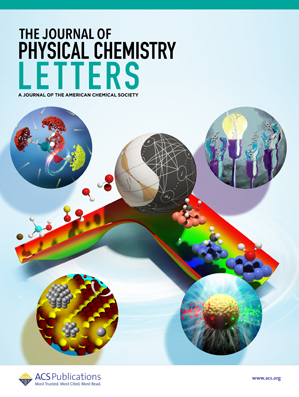范德华系统中腔诱导量子干涉和集体相互作用
IF 4.8
2区 化学
Q2 CHEMISTRY, PHYSICAL
引用次数: 0
摘要
这封信的中心主题是表明光-物质杂交不仅产生新的动态响应,而且可以改变分子间的相互作用并诱导新的结构秩序。以光学腔中的范德华(vdW)系统为例,预测了量子干涉和集体效应对腔诱导多体色散力的影响。具体来说,由于空腔诱导的量子涨落导致了3体和4体vdW相互作用,它们可以对齐分子间向量,而不是成对相加。此外,腔诱导的偶极子导致单个分子的能量转移,使单个分子对齐,并产生成对的相互作用,其尺度为R-3而不是标准的R-6距离尺度。所有这些空腔诱导相互作用的系数取决于空腔频率,并由有效拉比频率重新规范化,而有效拉比频率又取决于粒子密度。最后,我们研究了空腔中vdW系统与外部物体的相互作用,发现由于修改了距离标度律,相互作用范围显著增强。这些理论预测表明了腔诱导向列序或近序的可能性,并可能为理解在光学腔中观察到的有趣现象提供重要线索,例如强修饰的基态反应性,离子输运和电荷迁移率。本文章由计算机程序翻译,如有差异,请以英文原文为准。

Cavity-Induced Quantum Interference and Collective Interactions in van der Waals Systems
The central topic of this letter is to show that light-matter hybridization not only gives rise to novel dynamic responses but can also modify intermolecular interactions and induce new structural order. Using the van der Waals (vdW) system in an optical cavity as an example, we predict the effects of quantum interference and collectivity in cavity-induced many-body dispersion forces. Specifically, the leading order correction due to cavity-induced quantum fluctuations leads to 3-body and 4-body vdW interactions, which can align intermolecular vectors and are not pairwise additive. In addition, the cavity-induced dipole leads to a single-molecule energy shift that aligns individual molecules, and a pairwise interaction that scales as R–3 instead of the standard R–6 distance scaling. The coefficients of all these cavity-induced interactions depend on the cavity frequency and are renormalized by the effective Rabi frequency, which in turn depends on the particle density. Finally, we study the interaction of the vdW system in a cavity with an external object and find a significant enhancement in the interaction range due to modified distance scaling laws. These theoretical predictions suggest the possibility of cavity-induced nematic or smectic order and may provide an essential clue to understand intriguing phenomena observed in optical cavities, such as strongly modified ground-state reactivity, ion transport and charge mobility.
求助全文
通过发布文献求助,成功后即可免费获取论文全文。
去求助
来源期刊

The Journal of Physical Chemistry Letters
CHEMISTRY, PHYSICAL-NANOSCIENCE & NANOTECHNOLOGY
CiteScore
9.60
自引率
7.00%
发文量
1519
审稿时长
1.6 months
期刊介绍:
The Journal of Physical Chemistry (JPC) Letters is devoted to reporting new and original experimental and theoretical basic research of interest to physical chemists, biophysical chemists, chemical physicists, physicists, material scientists, and engineers. An important criterion for acceptance is that the paper reports a significant scientific advance and/or physical insight such that rapid publication is essential. Two issues of JPC Letters are published each month.
 求助内容:
求助内容: 应助结果提醒方式:
应助结果提醒方式:


